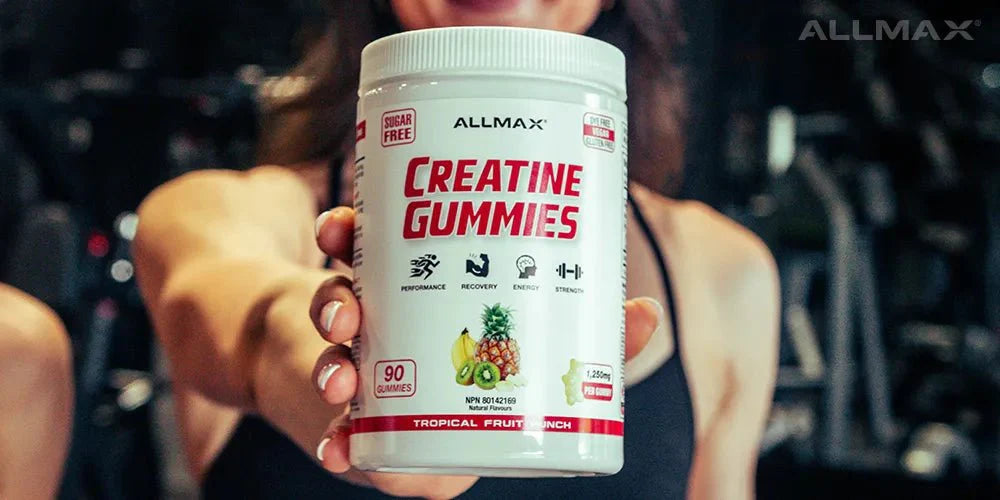Managing diabetes doesn’t mean giving up on building muscle. With the right training, nutrition, and recovery strategies, people with type 1 or type 2 diabetes can safely increase strength and size while keeping blood sugar under control. Learn how to balance workouts, diet, and supplementation to support both performance and long-term health.
Table of contents
What is Diabetes?
Diabetes mellitus is a chronic metabolic condition that affects how the body regulates blood sugar (glucose). Over time, high blood glucose can damage blood vessels, nerves, and organs, making it one of the most pressing global health issues. There are two main types: type 1 diabetes and type 2 diabetes, along with gestational diabetes and other rare genetic or secondary forms. Together, type 1 and type 2 account for the vast majority of cases worldwide.
Type 1 Diabetes
Type 1 diabetes usually develops suddenly and is often diagnosed in children, teens, and young adults, though it can occur at any age. It happens when the immune system mistakenly attacks insulin-producing cells in the pancreas, leaving the body unable to produce insulin. Without insulin, glucose accumulates in the bloodstream, leading to dangerous spikes in blood sugar.
Although genetic risk plays a role, environmental factors such as infections, nutrition, and vitamin D deficiency may also influence development. Type 1 diabetes requires lifelong insulin therapy and careful management, but with proper care, individuals can live active, healthy lives.
Type 2 Diabetes
Type 2 diabetes is far more common and develops gradually over time, often without obvious early symptoms. In this form, the body either becomes resistant to insulin or cannot make enough to maintain normal glucose levels. Many people may live for years without knowing they have it.
This type is strongly linked to lifestyle factors such as poor diet, lack of exercise, and obesity, though genetics and ethnicity also play a role. It is more common in adults but increasingly seen in children due to rising obesity rates. The good news is that type 2 diabetes can often be prevented, or effectively managed, through healthy eating, regular physical activity, and weight control.
How to Build Muscle with Diabetes Safely

Building muscle with diabetes is absolutely possible, but it requires a smart and structured approach. Resistance training improves insulin sensitivity, supports stable blood sugar, and helps manage body weight—making it one of the most beneficial forms of exercise for individuals with type 1 and type 2 diabetes. The key is consistency, balanced nutrition, and careful monitoring of glucose before, during, and after workouts.
To train safely:
-
Monitor blood sugar: check levels regularly, especially around training sessions. For competitive or intense training, frequent checks are recommended—before and after meals, as well as before, during, and after workouts.
-
Fuel properly: prioritize complex carbs, lean protein, and healthy fats to sustain energy and recovery. During prolonged or high-intensity sessions, 15–60 g of carbohydrates may be needed to prevent hypoglycemia. Sports drinks with 5–10% carbohydrate can be a good option.
-
Stay hydrated: dehydration can affect blood sugar control and performance.
-
Balance intensity: aim for progressive overload but avoid extreme fatigue, which can increase the risk of hypo- or hyperglycemia.
-
Adjust insulin smartly: athletes may need to reduce insulin doses by 20–50% around exercise. For individuals on pump therapy, adjustments to basal and bolus doses are often necessary. Insulin injections should be administered more than 60 minutes before activity, and injection sites should be rotated within the same region to ensure consistent absorption.
-
Rest and recover: quality sleep and recovery days are essential for muscle growth and blood sugar regulation.
Because exercise responses can be unpredictable—affected by duration, intensity, stress, and even weather—having a plan B is critical. Rapidly absorbable carbohydrates should always be available, and coaches or training partners should be aware of the signs of hypoglycemia and how to respond.
Can diabetic patients do bodybuilding?
Yes—people with diabetes can absolutely do bodybuilding. In fact, strength training is recommended by many health organizations as an important part of managing diabetes. Lifting weights helps increase lean muscle, which improves glucose uptake by the muscles and reduces insulin resistance. For those with type 1 diabetes, insulin adjustments may be necessary around training, while those with type 2 often see significant benefits in blood sugar control and overall health.
Research on competitive athletes with type 1 diabetes shows that many still struggle with optimal glucose control. Some intentionally compete with higher blood glucose levels to avoid dangerous drops during exercise. While this may reduce hypoglycemia risk, it can also increase long-term complications and susceptibility to infections—especially since sports often involve cuts, blisters, and minor injuries. A well-designed management plan, including target blood glucose ranges (set between 150–250 mg/dl for competition), helps minimize risks while supporting performance.
Safe bodybuilding with diabetes is not about pushing harder than everyone else—it’s about training smarter. With medical guidance, structured nutrition, personalized insulin strategies, and consistent workouts, building a strong, muscular physique is both safe and effective. For athletes seeking extra support, organizations such as the Diabetes Exercise and Sports Association provide valuable resources and shared experiences to help individuals with diabetes excel in sports and fitness.
Practical Tips for Athletes with Type 1 Diabetes

-
Aim to start workouts with blood glucose in the 150–250 mg/dl range.
-
Monitor glucose levels before, during, and after workouts, and occasionally overnight (around 2:00 a.m.) when training intensity increases.
-
Reduce insulin doses by 20–50% before intense activity; pump users may pause basal insulin during exercise and reduce it by ~25% afterward.
-
Take insulin at least 60 minutes before activity to avoid accelerated absorption. Rotate sites within one region.
-
Supplement with 15–60 g of carbs during long or intense training. Sports drinks with 5–10% carbs work well.
-
Always keep fast-acting carbohydrates on hand, and ensure teammates and coaches are trained to recognize and manage hypoglycemia.
-
Treat cuts, blisters, and scrapes promptly to reduce the risk of infection.
Practical Tips for Athletes with Type 2 Diabetes
-
Monitor glucose regularly around training—especially when changing diet, medication, or workout intensity.
-
Focus on gradual, consistent training. Strength training improves insulin sensitivity and glucose control.
-
Prioritize weight management with a balance of resistance training, cardio, and proper nutrition.
-
Emphasize whole foods: lean protein, complex carbs, and healthy fats to support both blood sugar stability and muscle growth.
-
Stay hydrated to help regulate blood glucose and performance.
-
Treat rest and recovery as essential tools; adequate sleep reduces insulin resistance and promotes muscle repair.
-
If using medication, consult a healthcare provider about how exercise may affect dosage needs.
Diabetic Bodybuilding Diet
Eating well is the foundation of both performance and safe blood sugar management for athletes with diabetes. A smart plan doesn’t just fuel workouts — it also supports recovery, helps build muscle, and keeps glucose levels stable. Here’s what to focus on:
Carbohydrates
Carbs are the body’s main energy source, especially for intense training. For athletes with diabetes, the key is timing and type.
-
Before workouts: Choose fast-digesting carbs like rice, pasta, or sports drinks to fuel performance.
-
During exercise: Mix glucose with other carbs (like fructose) for steady energy and reduced hypoglycemia risk.
-
After training: Aim for 1.0–1.3 g of carbs per kg of body weight per hour for about 4 hours to restore glycogen.
Some alternatives, such as fructose, isomaltulose, or galactose, may lower insulin needs and reduce blood sugar fluctuations.
Protein

Protein repairs muscles and supports growth. Athletes with diabetes should aim for 1.2–2.0 g per kg of body weight per day. Protein intake can be further increased with whey protein isolate powders, which provide high-quality protein with minimal impact on blood sugar.
-
Spread intake across meals (20–30 g each).
-
Combine with carbs after training to improve glycogen storage.
-
Remember: higher protein often means adjusting insulin doses.
Fats
Healthy fats provide long-lasting energy and support hormone balance. Good choices include olive oil, nuts, seeds, and poultry. But:
-
High-fat meals raise insulin requirements.
-
Keep fat intake lower right before and after workouts.
Hydration
Diabetes can affect sweating and thirst signals, so structured hydration is important.
-
Replace 125–150% of fluids lost during exercise (about 1.25–1.5 L per kg of body weight lost).
-
Use water for shorter sessions, and carb-containing drinks for long or intense workouts.
Micronutrients
Electrolytes like sodium, potassium, and magnesium are essential for muscle function and hydration. Vitamin D, omega-3s, and antioxidants may also help with recovery and immune health.
Caffeine
Moderate caffeine (200–250 mg) before training can:
-
Improve alertness and endurance
-
Boost hormonal responses
-
Help with hypoglycemia awareness
However, excessive caffeine can disrupt sleep, so it should be used in moderation.
The bottom line: athletes with diabetes should personalize their nutrition. Balancing carbs, protein, fats, hydration, and caffeine with blood glucose monitoring and insulin management allows athletes to perform at a high level while staying safe.
Diabetic Bodybuilding Supplements
Building muscle safely with diabetes means choosing supplements that support performance and recovery with minimal impact on blood sugar. Here’s a look at the top options that align well with those goals:
-
What it is: A premium whey protein powder that delivers around 24–30 g of protein per scoop with very low carbs (~4 g) and minimal sugar (about 2 g).
-
Why it’s good for diabetic athletes: Provides high-quality protein essential for muscle repair and growth, without causing blood sugar spikes. Clean ingredients and low-carb formulation make it an excellent post-workout recovery option.
-
What it is: A widely researched and highly effective supplement to increase strength, muscle volume, and high-intensity performance.
-
Why it’s good for diabetic athletes: Creatine doesn’t affect blood glucose levels and supports better training performance—making it a safe and effective addition for strength goals.
3. BCAA 2:1:1 (Branched-Chain Amino Acids)
-
What it is: A formulated blend of leucine, isoleucine, and valine to aid muscle recovery and reduce fatigue.
-
Why it’s good for diabetic athletes: BCAAs help preserve muscle mass without supplying carbs—ideal during fasted states or when you need extra recovery support without impacting glucose.
Supplementing smartly with the right products can enhance your bodybuilding journey, even when managing diabetes. Focus on options that deliver results without compromising blood sugar control. When in doubt, always consult your healthcare provider to adjust insulin or medications when adding new supplements.
Our Ambassador's Story of Building Muscle with Diabetes
For ALLMAX Ambassador Steven Mott, going the extra mile in terms of training and nutrition is a necessity, not an option. Diagnosed with Type 1 diabetes just days before his 15th birthday, Mott has been adapting his lifestyle ever since. While diabetes is not a death sentence, it does require constant vigilance and dedication to manage effectively.
“I have to give myself insulin injections at meal times and correction doses as needed,” Mott explains. “I also have long-acting insulin that I have to take before bedtime to help control my blood glucose levels throughout the day."
Mott’s bodybuilding pursuits don’t make things any easier. Maintaining stable blood sugar levels during exercise is crucial, as fluctuations can not only disrupt a workout but also be dangerous. Unfortunately, these changes can happen without warning.
“There are times I can be just getting to the gym, or during training and I start to feel very dizzy and lightheaded,” Mott says. “When that happens, I have to stop training, test my sugar, eat some quick carbohydrates and wait about 10 to 15 minutes before testing again and getting back to training.”
Both high and low blood sugar levels can cause problems, so Mott always makes sure to bring his blood glucose monitor and a sugary drink to the gym. Despite the challenges, he believes that bodybuilding has been highly beneficial for his overall health.
“Getting into bodybuilding and fitness has probably been the best thing I have done for my diabetes. It’s one of the best medications for a diabetic,” Mott says. “Your blood sugars are better, you feel great, lose fat, your body utilizes insulin better and you really get to know your body better.”

In addition, diabetes has forced Mott to adopt a clean diet. While this supports his fitness goals, managing cravings can be challenging at times, but there are solutions.
“If I ever have a craving for some candy there are tons of great options, like the ISOFLEX protein bars – they are a great source of low-glycemic carbohydrates, because they have fiber and only one gram of sugar, so they have no effect on my blood sugars,” says Mott. “But the best part is they taste like candy bars!”
Ever since his diabetes diagnosis, Mott has been determined to overcome the challenges as much as possible. He hopes to enter the world of competitive bodybuilding one day. Until then, he is doing everything he can to prepare himself to the best of his ability. “I map out my blood sugars to see how my body reacts to the food I eat, as well as to insulin at different times of the day,” Steven explains. “From mapping my sugars, I noticed I needed more insulin in the morning. Once I began using R-ALA at those times, it solved the problem.” Mott is also dedicated to helping others with diabetes succeed in their fitness pursuits and is happy to offer guidance to those striving to maximize their efforts and manage the condition effectively.

“I really recommend getting to know your body – learn how certain foods affect you, and how insulin affects your blood sugars at different times of the day,” Mott says. “Other than that, just eat healthy and eat the foods that work best with your body. If you don’t have your health, then what do you have?”
While some might see competing with diabetes as unfair, Mott views it as another opportunity to showcase the power of determination and discipline. He keeps everything in perspective, focusing on his goals rather than the opinions of others. In his pursuit of bodybuilding, there is no room for excuses regarding the challenges of diabetes.
“I’m not planning to compete until I feel I can walk on stage and know I can place in the top three,” Mott says. “I’m waiting until I’m genuinely happy with my physique.”
References
-
Forouhi, N. G., & Wareham, N. J. (2019). Epidemiology of diabetes. Medicine, 47(1), 22-27. https://pdf.sciencedirectassets.com/273575/1-s2.0-S1357303918X00115/1-s2.0-S1357303918302640/main.pdf
-
Hornsby Jr, W. G., & Chetlin, R. D. (2005). Management of competitive athletes with diabetes. Diabetes Spectrum, 18(2), 102-107. https://diabetesjournals.org/spectrum/article/18/2/102/1846/Management-of-Competitive-Athletes-With-Diabete
-
Jurek, J. M. (2024). Dietary Approaches in Endurance Athletes with Diabetes–Nutritional Support. Case Rep Rev Open Access, 5(2), 143. https://gnoscience.com/uploads/journals/articles/744730557214.pdf



